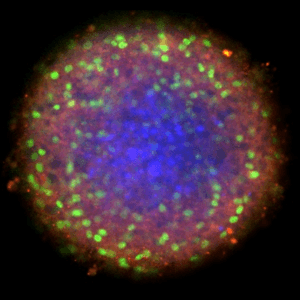Cancer Drug Screening
Assessment of efficacy of chemical libraries and lead compounds for efficacy on cancer cells is a service provided by Visikol.
Overview

Visikol specializes in assays for the screening of anti-cancer drugs. We offer numerous assays to clients for evaluating the efficacy and potential toxicity of cancer therapeutics. Utilizing High Content Screening, our assay formats provide the ability to simultaneously measure multiple endpoints. We offer assay formats using traditional monolayer models, as well as 3D cell culture models, which better recapitulate the tumor microenvironment in vivo.
In addition to standard measures of cancer drug efficacy such as anti-proliferative effect, and assessment of cell viability after treatment, the use of 3D cell models provides access to more complex measures that are difficult to assess in standard monolayer formats. These include assays for immune cell infiltration into 3D tumor spheroids, as well as assaying the penetration and distribution of biologicals into tumor spheroids. Since these assays are conducted in a well-plate format, they are amenable to larger screening campaigns to assess the efficacy of therapeutic strategies.
Please explore our website to learn more about the assays we offer.
Background
- Profiling the cytotoxicity of test compounds on cell monolayers or 3D cell models involves measuring the viability of the cells using molecular probes which bind to dead cells. Cytotoxicity, determined by measuring decreases in cell viability, is an important endpoint in the evaluation of the safety and toxicity of drug compounds, and a critical measure of the effectiveness of antineoplastic agents on cancer cells.
- In conjunction with other assay endpoints, such as the assessment of cell proliferation or apoptosis, the measurement of cell viability is a useful tool for interrogating the effect of cancer drugs in vitro [1].
- High Content Screening of 2D or 3D models paired with a fixable viability dye can be utilized to evaluate the cytotoxicity and/or cell viability of therapeutic drugs for clients.
- In addition to High Content Screening, Visikol offers cell viability quantification via higher throughput endpoints such as MTT assays and CellTiterGlo.
- 3D cell culture models effectively recapitulate the in vivo tumor environment, and are an effective tool for the evaluation of cytotoxic effects of promising anti-cancer drug compounds.
- Assessment of cell viability is critical for the evaluation of the safety and toxicity of test compounds. Assaying the cytotoxicity of compounds in 3D hepatocellular models is an excellent method for identifying and eliminating lead compounds that possess toxic liabilities early in the drug discovery process.
- This assay can be coupled with up to two other imaging-based endpoints (e.g. cell proliferation and apoptosis).
Protocol
| Instrument | Molecular Devices ImageExpress Micro Confocal |
| Analysis Method | High content screening |
| Markers | Fixable Viability Dye DAPI (total cell count) Other dead cell probes available on request |
| Cell Model Type | 3D cell models (e.g. tumor spheroids) or adherent monolayer / cell suspension |
| Cell Types Available | HepG2, A549, other ATCC cell lines available on request Client provided cells |
| Test Article Concentration | 8 point assay (0.05, 0.1, 0.5, 1, 5, 10, 50, 100 µM) (custom concentrations available) Single point assay |
| Number of Replicates | 3 replicates per concentration |
| Quality Controls | 0.5% DMSO (vehicle control) Staurosporin (positive control) |
| Test Article Requirements | 50 uL of 20 mM solution or equivalent amount of solid |
| Data Delivery | Dose response curves, LD50 values, total cell counts, Viability % for each test concentration Evaluation of statistical significance of results with respect to vehicle and positive control |

